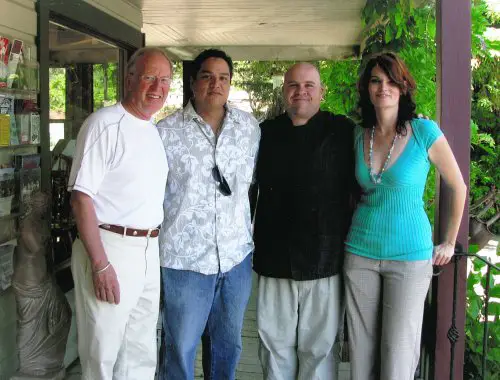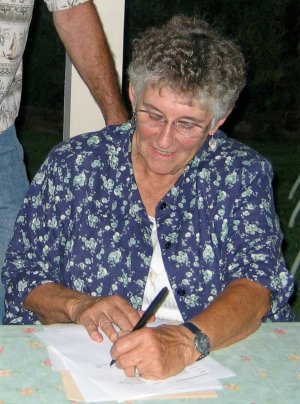- Lake County News reports
- Posted On
Chef John Ash helps kick off Wine Auction Weekend this month

LAKE COUNTY – This year's Lake County Wine Auction will be the centerpiece of a weekend filled with activities that celebrate great wine and food while raising funds for worthy community causes.
The Wine Auction will be held on Saturday, Sept. 20, under the big tent at the Buckingham Golf and Country Club in Kelseyville.
John Ash, internationally recognized wine country chef, educator and author, is a special guest of the Lake County Wine Alliance during the ninth annual Wine Auction.
During a cooking demonstration and luncheon on Friday, Sept. 19, the day preceding the gala Wine Auction charity benefit, Ash will present an ambitious menu that starts with an antipasti plate of wild mushrooms, grilled asparagus with lemon olive oil and Pecorino, and grilled shrimp with Sangrita. His “Fire and Ice” Pear Salad is served with goat cheese, figs and Proscuitto.
The menu moves on to an entrée of fresh halibut in a spicy coconut curry broth and ends with a dessert of lemon polenta cake with fresh raspberries.
Each course of the meal will be paired with a fine Lake County wine, representing several of the vintners participating in the annual Wine Auction.
A limited number of tickets are available for the cooking demonstration and luncheon, which will start at 10 a.m. at the Buckingham Homeowner’s Association Clubhouse, 2850 Eastlake Drive, Kelseyville. Each ticket is $75 per person, after the purchase of a Wine Auction ticket for $100 per person.
Chef Ash will be assisted in the demonstration and in preparing the luncheon by Lake County chefs Jeremy Zabel of the Saw Shop Gallery Bistro in Kelseyville, Robert Cabreros of the Yuba College Culinary Arts Program and Julie Hoskins of Chic Le Chef in Hidden Valley Lake. Students from Yuba College will serve the meal.
Other special events on the evening of Friday, Sept. 19, include winemaker dinners hosted by six Lake County wineries at special venues. Participating wineries are Ceago Vinegarden, Langtry Estate, Moore Family Winery, Shannon Ridge Winery, Steele Wines and Wildhurst Vineyards. Capacity at each venue is limited. Tickets are $75 per person, after the purchase of a Wine Auction ticket.
The Wine Auction will be held at the Buckingham Golf and Country Club, 2855 Eastlake Drive, Kelseyville on Sept. 20.
U.S. Congressman Mike Thompson, First District of California, is the event chair. Andy Beckstoffer, CEO of Beckstoffer Vineyards, is the master of ceremonies. Auctioneers are Archie McLaren, founder of the Central Coast Wine Classic and a rare and fine wine consultant, and Jed Steele, owner and winemaker of Steele Wines of Lake County.
More than 20 Lake County wineries will pour wines, and 12 restaurants and caterers will present food to accompany the vintners’ selections. The evening includes live and silent auctions of wine lots, wine and travel packages, and fine art. Jim Williams and Friends will provide music for dancing.
Ten community organizations and agencies that work hard to make Lake County a better place have been chosen to receive the proceeds of this year’s Wine Auction. Over the past eight years, the Lake County Wine Alliance has donated more than $621,500 to local programs.
The beneficiaries this year are Kids 4 Broadway, Lake County Special Olympics, Wiloth Equine Therapy and Riding Center, Hospice Services of Lake County, Adult Day Care/Respite of Clearlake, the Military Funeral Honors Team, Church Women United, Operation Tango Mike, the Lake Family Resource Center, the County Literacy Coalition and the fine arts programs at five Lake County high schools.
The Buckingham Junior Golf Program receives support through the auction of golf balls to fund activities of the Lake County Junior Golf Council.
Members of the Wine Alliance board include Margaret Walker-Stimmel, president; Marie Beery, vice president; Pamela Shine-Duncan, secretary; Rob Roumiguiere, treasurer; and Jim Fetzer, Judy Luchsinger, Wilda Shock and Janet Thompson. The volunteer board and a large Wine Auction committee of volunteers meet year round to plan the charity event.
For more information and to purchase tickets for any of the events, call 866-279-WINE.
{mos_sb_discuss:2}

 How to resolve AdBlock issue?
How to resolve AdBlock issue? 






